The Giving Tree Gave to Me…
Angeliki Voreopoulou, Greece
Angeliki Voreopoulou has been an ELT practitioner since 1998. She is currently working in a State Primary school in Northern Greece. She has won a prize for implementing board games in teaching English to very young learners at the Day Conference on Early Language Learning organized by the Greek ministry of Education and the University of Athens. She stimulates her students’ creativity by engaging them in projects fostering critical thinking, collaboration and communication. She shares her practice in seminars, talks and workshops. Her main interests include visual materials, storytelling and the use of Web 2.0 tools into the classroom. E-mail: avoreopoulou@hotmail.com

Menu
Introduction
Familiarise students with the story
Making our Giving Tree
The Word Whisperers
A thank you letter
Sequels to the story
Improvisations
Wrapping up our story – a crafty memento
Conclusion
Creativity in my teaching
All Children have an innate love for stories. Whether they are bedtime stories or narrated during school time by their teacher, stories captivate children’s attention, unleash their imagination and creativity while encouraging active participation and enhancing all four skills. Children’s willingness to share and communicate thoughts and feelings is increased and at the same time their cooperation with the others is maximised. Stories can also teach us about the world, other cultures and customs but very frequently focus on understanding life itself, ourselves and the others.
One of these stories is The Giving Tree by Shel Silverstein. The activities presented below were weaved around this very famous story and they aimed at developing students’ English language performance through the use of Technology, games and improvisations as well as art and craft. Additionally, the story gave opportunities for developing students’ emotional intelligence, increasing their self-esteem and ameliorating their relationships with the ‘others’ (ie friends and family). The project lasted almost a term because we devoted a teaching hour per week.
Warm up: Teacher pre-teaches parts of the tree and students brainstorm the importance of trees to the environment and to humans.
Task 1: Teacher reads the story to the students or uses the Youtube narration.
Task 2: Students can listen to the story again but this time they pay close attention to the various stages of the boy’s life. They keep notes as to what the tree gives to the boy and about the fact that the boy does not respond to the tree’s generosity. Using their notes they have to create a mind map with Bubbl.us which is going to work as a reference point to further activities.
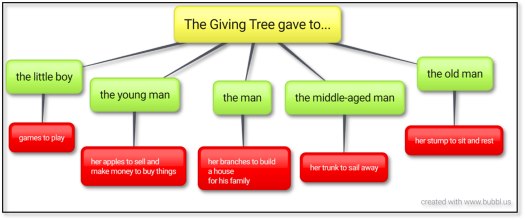
Task 3: Students discuss in groups and then they report to the class the heroes’ feelings every time they meet (they can use their mind maps as reference). For instance: ‘How does the boy and the tree feel at the beginning of the story?’ Brainstorming and dictionary search is encouraged so as students to come up with words like love, happiness, generosity, sharing, sad and disappointed.
Task 4: Students get in pairs or in small groups and they create different word clouds using the feelings from Task 3. The word clouds below were created using Wordart
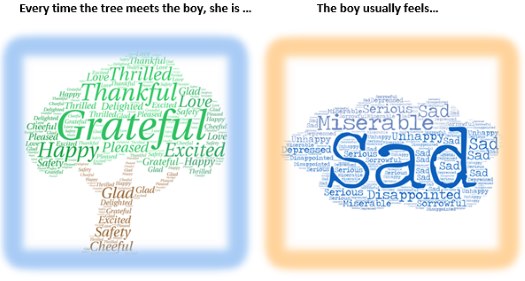
Task 5: Students sit a circle. Two of them stand up and pretend being ‘the Statue and the Artist’. The Artist gives different shapes to the Statue depicting the boy’s feelings at the various stages of the story. The rest of the students guess the feeling and the stage of the story. They justify their answers by referring back to the mind map and retelling parts of the story.
In an effort to personalize the story and to develop students’ emotional intelligence, learners reflect on their personal actions in terms of giving and discuss the questions:
‘Who is the giving tree in your life?’, ‘Do you behave like the boy?’, ‘How can you become more giving?’
At the end of the discussion/ brainstorming students write the ideas that apply to their personalities on three paper tree leaves that the teacher has already prepared in advance. Then students cut and colour them. When everyone is finished, they gather around a tree made of construction paper and one after the other they stand up and announce to the rest of the class how they can become more giving in their life and/ or what is the true meaning of ‘giving’ to them. Very soon the Giving Tree of the class blooms and it is a reminder of benevolent actions and positive feelings throughout the school year.
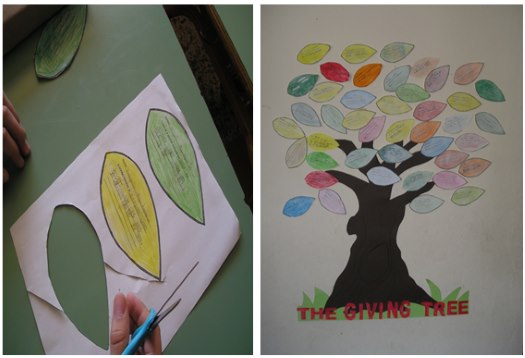
This is how it felt while Making Our Giving Tree.
One of the recurring ideas from the previous activity is ‘being polite and kind’, ‘saying nice things to the others’. So the best way to put words into actions is by playing a game that allows students to practice words recently acquired and to boost their self-esteem. The Word Whisperers is a simple activity that requires students to be standing in two rows, facing each other with their hands raised so as to create a long tunnel. Every time a student walks through that tunnel, the rest of the players will have to whisper positive words that apply to his / her personality like ‘you are kind, beautiful, and happy’. The teacher as well can join the game and receive positive comments while setting the example (I was called smiling, patient and polite!) By the end of the activity everyone will be exposed to great dose of positive energy which is particular beneficial to shy, low profile students who would not receive positive comments from others that easily.
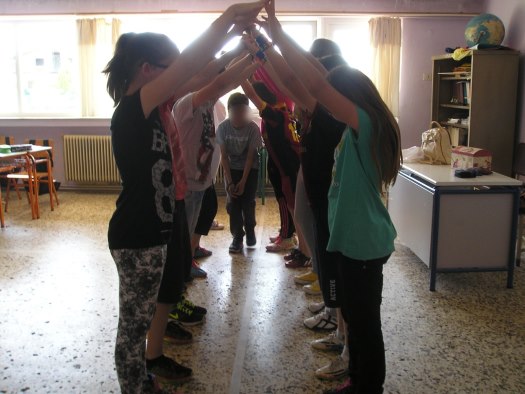
This is an activity inspired and adapted by one of my favourite blogs: ELT Inspired
As a follow up, the teacher asks students to write a letter to one of their classmates thanking him/her for being friends while commenting on his/her gifts and assets as personalities. Students post them in a special mail box and teacher delivers them the following day. All of the students get thrilled when receiving such a letter. Positive comments and the revelation of the impact their personalities can have on others usually boosts their self-confidence and improves their public image.
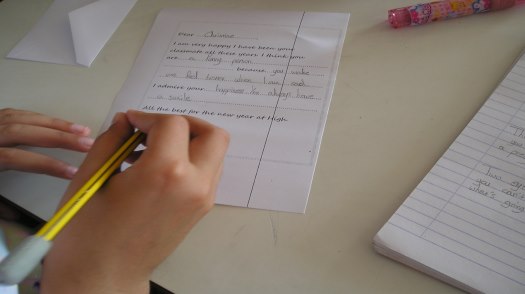
A Thank you Letter
According to my group of students, the ending of the story was a sad one and they wanted more action towards the end of the story. Therefore, students can be asked to write lovely sequels to the story full of optimism and a sense of rebirth. Here is an example of what Christine, a 6th grade student, has written.
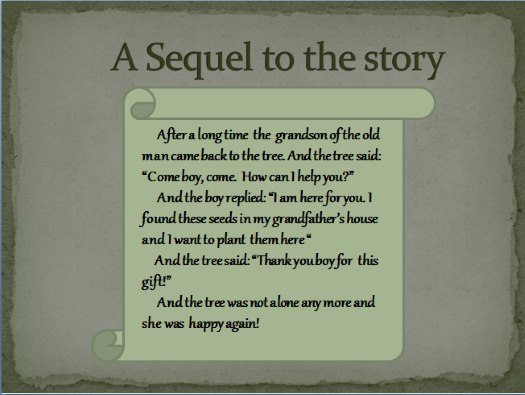
The story of the Giving Tree offers unique opportunities for improvisations. Students can work collaboratively, spontaneously and create something completely unique out of a single spark of imagination. All learners can benefit from improvisations and find their place in the act while developing their emotional and language skills. Hyperactive students can learn how to wait for their turn, stay focused and control their energy whereas more reserved learners can gain confidence and be exposed without the fear of making mistakes since all answers are acceptable and well appreciated. Below are some improvisation ideas that can be easily used with students who have read the Giving Tree. The teacher introduces the background information of the scene and the students develop brief dialogues within a few minutes. Having used all three improvisation ideas with my learners I can tell that the results were really imaginative and interesting.
1. Interviews
The teacher tells the class: ‘While the old man was sitting alone someone approached him. He was a reporter taking his walk and looking for a new topic to write. He saw the lonely man and started asking questions about his life. The old man was happy to answer them. Can you guess what they were talking about?’ Students get in pairs. One takes the role of a reporter and the other the role of the old man in the story. They prepare and present in class an interview concerning the reasons why the old man behaved like that throughout his life.
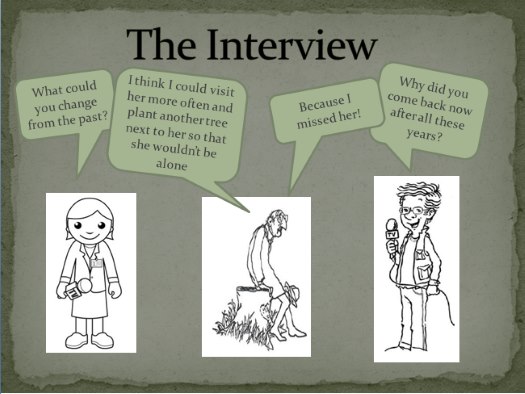
Young reporters interview the old man. They are all 6th graders who had a lot of questions to ask about the old man’s behavior from the very first moment we had read the story. Big ‘Why’ questions were turned into short dialogues.
2. Occasional dialogues between the boy and the tree
The teacher tells the students: “The wind blows softly today and the conversation between the little boy and the tree has reached our ears. What are they talking about?” Students get in pairs. One takes the role of the tree and the other the role of the little boy. They present in class possible dialogues between the boy and the tree that might include their daily news or even a big secret. Students’ imagination usually thrives at that point!
3. The boy’s toys complain!
The teacher tells the students: ‘The boy used to spend all of his free time with the tree and back in his bedroom his toys started getting worried and sad because the boy was never there; he didn’t play with them anymore. One evening when the boy returned they decided to talk to him and ask him why he prefers playing with the tree instead of them”. Students get in pairs. One pretends being the boy and the other a toy. They prepare a short dialogue with the toy complaining and the boy trying to explain why he enjoys playing with the tree.
Towards the end of the ‘Giving Tree’ project, students assemble all the work they have completed, their mind maps, their sequels, notes on their improvisations and create a mini-book that has the shape of a tree. On the green leafy part of the tree they can write words that they have learnt throughout the project and which have a particular value to them. The main body of the tree – the trunk- can be folded in such a way so as to enclose students’ written work. This crafty memento can decorate the classroom wall for a while before students take it back home as a reminder… of the project and the importance of the act of giving!
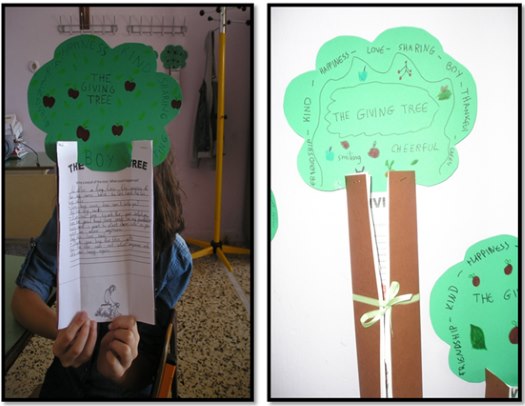
You can have a better look at these mini-books here.
The Giving Tree gave to my students a chance to practice speaking, writing, reading, listening and note-taking. Most importantly though, they had the opportunity to rethink of their actions and to become more giving towards their friends and family. They developed their emotional intelligence and they boosted their self-esteem. The Giving Tree gave to me the chance to unleash my students’ creativity while engaging them in English language lessons that nurtured both their heart and mind.
In 1998 I graduated from University of Kent at Canterbury full of anticipation in starting teaching English, the language that I had cherished using the most during my studies in England. As a novice teacher at the crack of 21st century I used to follow the Teacher’s Guide, which was a true companion to me, but very soon I started adapting course materials and introducing activities that seemed more engaging and motivating to students because they involved art, games, improvisations and role plays. Searching through the internet I discovered that what I had intuitively chosen to follow was a more creative and humanistic approach to language teaching which was supported by theories and research. A few years ago I joined the C Group realizing that there are other language teachers who share the same interests and attitudes towards teaching as I do.
Ever since, creativity has become the driving force in my lessons mainly because of its strong impact on students’ motivation. The variety of activities that can be organized using a diversity of subjects, topics and perspectives can bridge two completely different domains while increasing students’ interest and curiosity. Therefore, they start approaching language learning with a more inquisitive attitude and overcoming obstacles more easily.
What is more, creative activities cater for different learning styles and needs. In a school environment where students are engaged in learning through songs, visuals, art, games, TPR activities they are constantly exposed to a variety of stimuli benefiting their linguistic development. For instance, revision of vocabulary and/ or grammar can be a fascinating experience when students design their own board games and use the target vocabulary and grammar items as clues that can help them win. Alternatively, students can practice adjectives describing personality traits by writing their self-portrait poems which can later be used to decorate their portraits painted by themselves! Also, technology and Web.2 tools can help learners create e-books and online comics to name but a few that can make even the most reluctant students start practice writing in a foreign language.
What I mean by these examples is that I strive to teach creatively because I firmly believe that English language teachers should not only demonstrate the rules of correct grammar use and vocabulary. They are there to help their student develop emotionally, increase their self-esteem along with a feeling of success while enjoying language learning and viewing it as a meaningful and well-worth experience. Creative teaching can also help students discover new talents, diverse strengths and latent abilities needed not only for language learning but for lifelong education since creativity encourages flexible thinking and resourcefulness. Above all, a more creative approach to learning will train learners to succeed in the challenges of the 21st century since there is need of innovative individuals, discovers and entrepreneurs to face the international financial crisis, world hunger, immigration, poverty and lack of energy resources.
I adopted creative teaching intuitively (at least at the beginning) because I observed that this approach helped my learners bloom and look forward to my English lessons. Creativity also gives me a feeling of fulfillment and success because I can see happy faces, motivation and language improvement in all of my students.

Please check the Creative Methodology for the Classroom course at Pilgrims website.
Please check the Methodology and Language for Primary course at Pilgrims website.


|